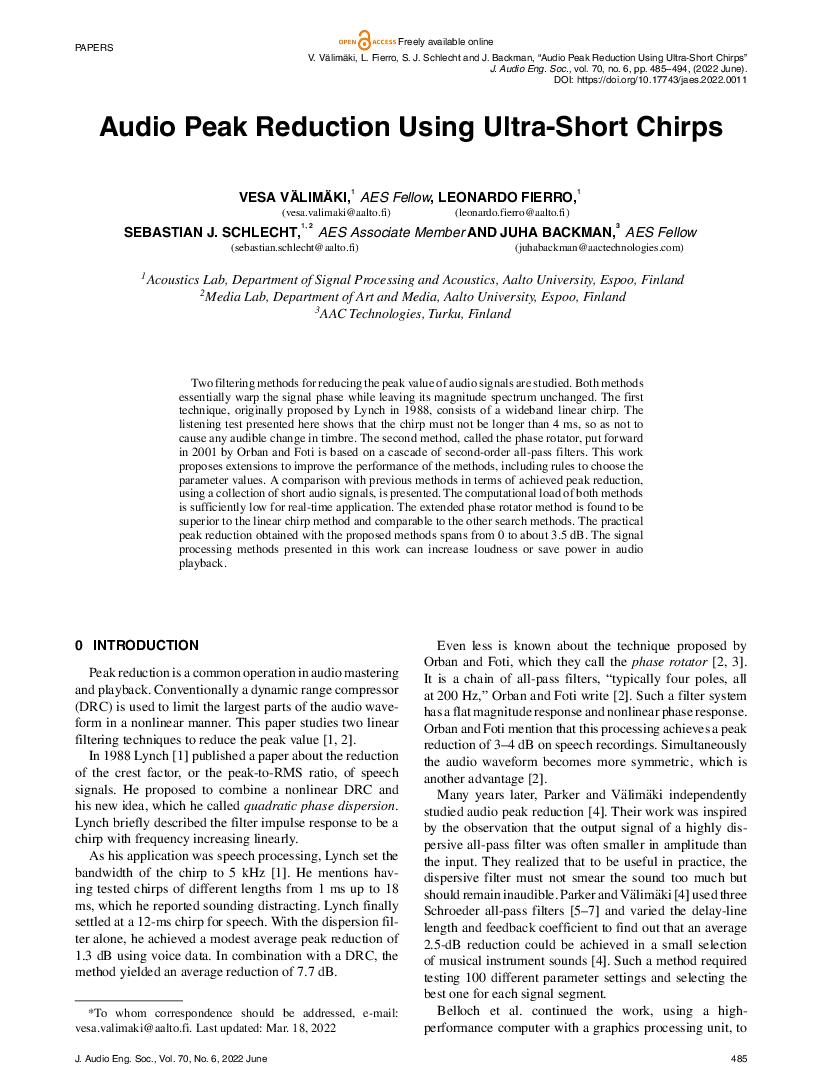Home / Publications / E-library page
You are currently logged in as an
Institutional Subscriber.
If you would like to logout,
please click on the button below.
Home / Publications / E-library page
Only AES members and Institutional Journal Subscribers can download
Two filtering methods for reducing the peak value of audio signals are studied. Both methods essentially warp the signal phase while leaving its magnitude spectrum unchanged. The first technique, originally proposed by Lynch in 1988, consists of a wideband linear chirp. The listening test presented here shows that the chirp must not be longer than 4 ms, so as not to cause any audible change in timbre. The second method, called the phase rotator, put forward in 2001 by Orban and Foti is based on a cascade of second-order all-pass filters. This work proposes extensions to improve the performance of the methods, including rules to choose the parameter values. A comparison with previous methods in terms of achieved peak reduction, using a collection of short audio signals, is presented. The computational load of both methods is sufficiently low for real-time application. The extended phase rotator method is found to be superior to the linear chirp method and comparable to the other search methods. The practical peak reduction obtained with the proposed methods spans from 0 to about 3.5 dB. The signal processing methods presented in this work can increase loudness or save power in audio playback.
Author (s): Välimäki, Vesa; Fierro, Leonardo; Schlecht, Sebastian J.; Backman, Juha
Affiliation:
Acoustics Lab, Department of Signal Processing and Acoustics, Aalto University, Espoo, Finland; Acoustics Lab, Department of Signal Processing and Acoustics, Aalto University, Espoo, Finland; Acoustics Lab, Department of Signal Processing and Acoustics, Aalto University, Espoo, Finland; Media Lab, Department of Art and Media, Aalto University, Espoo, Finland; AAC Technologies, Turku, Finland
(See document for exact affiliation information.)
Publication Date:
2022-06-06
Import into BibTeX
Permalink: https://aes2.org/publications/elibrary-page/?id=21801
(873KB)
Click to purchase paper as a non-member or login as an AES member. If your company or school subscribes to the E-Library then switch to the institutional version. If you are not an AES member Join the AES. If you need to check your member status, login to the Member Portal.

Välimäki, Vesa; Fierro, Leonardo; Schlecht, Sebastian J.; Backman, Juha; 2022; Audio Peak Reduction Using Ultra-Short Chirps [PDF]; Acoustics Lab, Department of Signal Processing and Acoustics, Aalto University, Espoo, Finland; Acoustics Lab, Department of Signal Processing and Acoustics, Aalto University, Espoo, Finland; Acoustics Lab, Department of Signal Processing and Acoustics, Aalto University, Espoo, Finland; Media Lab, Department of Art and Media, Aalto University, Espoo, Finland; AAC Technologies, Turku, Finland; Paper ; Available from: https://aes2.org/publications/elibrary-page/?id=21801
Välimäki, Vesa; Fierro, Leonardo; Schlecht, Sebastian J.; Backman, Juha; Audio Peak Reduction Using Ultra-Short Chirps [PDF]; Acoustics Lab, Department of Signal Processing and Acoustics, Aalto University, Espoo, Finland; Acoustics Lab, Department of Signal Processing and Acoustics, Aalto University, Espoo, Finland; Acoustics Lab, Department of Signal Processing and Acoustics, Aalto University, Espoo, Finland; Media Lab, Department of Art and Media, Aalto University, Espoo, Finland; AAC Technologies, Turku, Finland; Paper ; 2022 Available: https://aes2.org/publications/elibrary-page/?id=21801
@article{välimäki2022audio,
author={välimäki vesa and fierro leonardo and schlecht sebastian j. and backman juha},
journal={journal of the audio engineering society},
title={audio peak reduction using ultra-short chirps},
year={2022},
volume={70},
issue={6},
pages={485-494},
month={june},}